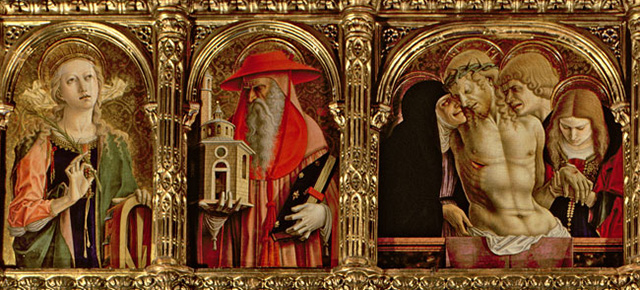Ornament & Illusion: Carlo Crivelli of Venice runs Oct. 22, 2015 – Jan. 25, 2016
Carlo Crivelli (about 1435–about 1495) is one of the most important – and historically neglected – artists of the Italian Renaissance. Distinguished by radically expressive compositions, luxuriant ornamental display, and bravura illusionism, his works push the boundaries between painting and sculpture. Crivelli manipulated the surface of each one with rare mastery of his medium, crafting visionary encounters with the divine, forging the modern icon, and offering a powerful alternative to new models of painting associated with Florence.
The exhibition brings together 23 paintings and the artist’s only known drawing. Newly cleaned and restored, the Gardner’s iconic Saint George Slaying the Dragon is the focal point for a two-part installation. The first reunites four of six surviving panels from Crivelli’s Porto San Giorgio altarpiece, of which the Gardner painting is a fragment. The second part introduces visitors to the artist’s repertoire of dazzling pictorial effects with some of his most important works in Europe and the United States.
 Included in Ornament and Illusion are unprecedented loans from The National Gallery, London; the Städelsches Kunstinstitut und Städtische Galerie, Frankfurt; the Museo di Castelvecchio, Verona; the National Gallery of Art, Washington, D.C.; and the Metropolitan Museum of Art, New York City. Together, the works assembled in Boston reveal the artist’s astonishing skill, encompassing artistic vision, and relentless ambition, restoring Crivelli to his rightful place in the pantheon of Renaissance painters.
Included in Ornament and Illusion are unprecedented loans from The National Gallery, London; the Städelsches Kunstinstitut und Städtische Galerie, Frankfurt; the Museo di Castelvecchio, Verona; the National Gallery of Art, Washington, D.C.; and the Metropolitan Museum of Art, New York City. Together, the works assembled in Boston reveal the artist’s astonishing skill, encompassing artistic vision, and relentless ambition, restoring Crivelli to his rightful place in the pantheon of Renaissance painters.
Crivelli was esteemed in his own time as a painter of rank and status. Born in Venice, he trained locally and joined a workshop in the mainland city of Padua, learning from the same master as the celebrated artist Andrea Mantegna (1430/1–1506). Exiled for adultery shortly after returning to Venice in 1457, Crivelli then embarked on a peripatetic career. Early successes on both sides of the Adriatic led to prestigious commissions in the Marches, a mountainous region of northeast Italy defined by its religious and ethnic diversity and ruled by competing feudal lords. He signed the immense high altarpieces for the cathedrals of Ascoli Piceno, in 1473, and Camerino, around 1490. Recognized for his remarkable artistic accomplishments with the aristocratic title of “knight,” Crivelli died around 1494.
The exhibition is organized by guest co-curator Stephen J. Campbell (Henry and Elizabeth Wiesenfeld Professor, Johns Hopkins University), guest co-curator Oliver Tostmann (Susan Morse Hills Curator of European Art, Wadsworth Athenaeum), and Nathaniel Silver (Assistant Curator of the Collection, Isabella Stewart Gardner Museum).
Ornament and Illusion: Carlo Crivelli of Venice is accompanied by a catalog edited by Stephen J. Campbell. Seven essays challenge the prevailing view of Crivelli as a provincial artist working in an anachronistic “gothic” style, investigate the facture of his paintings, and shed new light on his rediscovery by collectors. Catalog entries deliver new insights and up-to-date bibliography for each work in the exhibition. Contributing authors include C. Jean Campbell (Emory University), Francesco De Carolis (Università di Bologna), Thomas Golsenne (École Nationale Supérieure d’Art de Nice), Gianfranco Pocobene (Isabella Stewart Gardner Museum), and Alison Wright (University College London).
Isabella Stewart Gardner Museum
25 Evans Way, Boston MA, 02115
